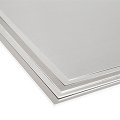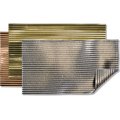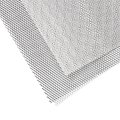Wire Mesh
Information on wire cloth
Like textile fibers, wires can be processed into fabrics. This is done by weaving warp wires (wires running in the longitudinal direction) with weft wires in the transverse direction. As a rule, the wires are cranked, i.e. slightly bent "around each other" so that a relatively firm connection is obtained. The most widely used wire cloth is the square mesh in the so-called canvas weave: a warp wire is bound by a weft wire and vice versa.
Wire cloth is referred to according to the mesh size w and the wire thickness d. In the designation of the mesh size (Mw), the mesh size is given in the first place and the wire thickness in the second place. The fabric Mw 1.6/0.3 has a mesh size of 1.6 mm and is made of a 0.3 mm thick wire. The thickness of the fabric is normally about twice the thickness of the wire.
The so-called sieve area F0, which indicates the percentage of mesh openings in the total fabric area, is of interest not only for technical applications:
F0 = (w2 x 100) / (w + d)2
As an alternative to metal fabrics, fibreglass fabric, expanded metal or shaped metal can be used.
Application of woven wire cloth
Wire cloth is manufactured for a variety of uses: Fine meshes as filters or screens (e.g. in paper production), coarser than conveyor belts, rabbit wire or screed reinforcement. There are also many possibilities to work with wire cloth in the field of design. In architectural model making it is a popular material for the representation of steel and glass constructions in working models. Covered with plaster bandages or papier-mâché, wire mesh can be used to create free shapes such as masks, sculptures or terrain structures for dioramas.
Processing the woven wire cloth
Fabrics up to a wire thickness of approx. 0.6 mm can still be cut well with simple scissors, above which a wire cutter or a side cutter should be used. Depending on the intended use, the fabric can be soldered or connected with wire. Reaction adhesives (e.g. based on epoxy or cyanoacrylate) can be used for gluing, rower plastic adhesives or Uhu Hard can also be used for model making.




